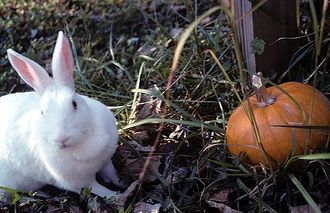Rabbits: Difference between revisions
Alechiggins (talk | contribs) No edit summary |
Alechiggins (talk | contribs) No edit summary |
||
| Line 6: | Line 6: | ||
[http://www.mofga.org/Publications/MaineOrganicFarmerGardener/Winter20092010/Rabbits/tabid/1392/ MOFGA Raising Rabbits on Pasture] | [http://www.mofga.org/Publications/MaineOrganicFarmerGardener/Winter20092010/Rabbits/tabid/1392/ MOFGA Raising Rabbits on Pasture] | ||
[https://www.youtube.com/watch?v=oz8o2uh9Lkw Pasture only rabbit system, Julie Engel] | |||
[https://www.youtube.com/watch?v=qO9hq6YWgms Selling rabbit manure] | |||
[https://www.youtube.com/watch?v=gjBa0DGSMyg Feeding rabbits on cut forage] | |||
[http://www.crossroadsrabbitry.com/profits-in-raising-rabbits/ Rabbit profits, Crossroads Rabbitry] | |||
[http://www.legendarydartmoor.co.uk/rabb_warr.htm Traditional English rabbit mound system] | |||
[http://www.permies.com/t/11645/rabbits/Pastured-Rabbits Pastured rabbits on Permies.com] | |||
[http://www.realworldsurvivor.com/2013/02/28/raising-em-wild-free/ Free range rabbit system] | |||
[http://raisingrabbitsessentials.com.s3.amazonaws.com/Raising-Rabbits-in-Colonies-fljaoy.pdf PDF on rabbits in colonies] | |||
Revision as of 15:33, 21 February 2016
Main > Food and Agriculture > Animal Husbandry
Links
MOFGA Raising Rabbits on Pasture
Pasture only rabbit system, Julie Engel
Rabbit profits, Crossroads Rabbitry
Traditional English rabbit mound system
Pastured rabbits on Permies.com
Rabbits at FeF
Housing
- John's cages (45 square feet, separated into six compartments
- Wood frame holds cages 4' off the ground
- Compartment to catch manure
Breeding
- New Zealand
- Litter size = 7-10 kits
Meat
- Average harvest weight = 4-5 pounds
- Yield percentage = 48%
Overview
Rabbits are a very easy way to provide meat for a resilient community or ecovillage. If you want to breed animals for meat, what could be easier to breed than an animal notorious for its fertility? Two does and a buck can easily produce 2kg of meat a week in a 1m2 enclosure. The buck should be kept separate, and the doe placed in the bucks enclosure for mating. Rabbits can be fed most leaves and grass. New Zealand white rabbits make about one unit weight of meat for every tree units of feed.
Droppings can be used to fertilize plants - no need to compost it first. The fur is useful too.
A good tip from Mike Oehler: Keep them in a wire cage, but cover the floor with about an inch of dirt. This way the rabbits don't have to walk on the wires, which must be unpleasant for them. To clean the cage, you remove the rabbit, lift the cage and shake it. The earth, fertilized by rabbit droppings, falls through and you gather it for gardening.
You can make delicious rabbit marinade by putting it in a pot with red wine, chives, pepper and other spices, soaking it like that overnight in the fridge and then roasting it slowly.
Rabbits are best harvested at 8-12 weeks of age. See How to skin & prepare a rabbit
Want to see a creepy survivalist guy giving you good advice on how to raise rabbits? I thought so. Check out these YouTube videos:
- Part 1, mostly about cages
- Part 2, mostly about breeding and birthing
- Part 3, showing how fast they grow
- Part 4, slaughtering and skinning them
- Part 5, butchering
According to this guide (which is packed with useful information), "the New Zealand White rabbit holds the title for being the top breed to raise for meat purposes due to overall practicality for both the processor and the grower, and closely followed by the Californian. This determination is based on size, growth rates, feed conversion ratios, dress-out weights and meat-to-bone ratios."
The New Zealand White is fertile year-round and has a gestation period of about one month.
Rabbit Fur
- Rabbit fur can be harvested ethically [1]:
See Also
- Good article on pros and cons of rabbits for meat - [2]
- Animals
- Wikipedia: Rabbits
- Peace-Corps: A Complete Handbook on Back-Yard and Commercial Rabbit Production
- books on raising rabbits
